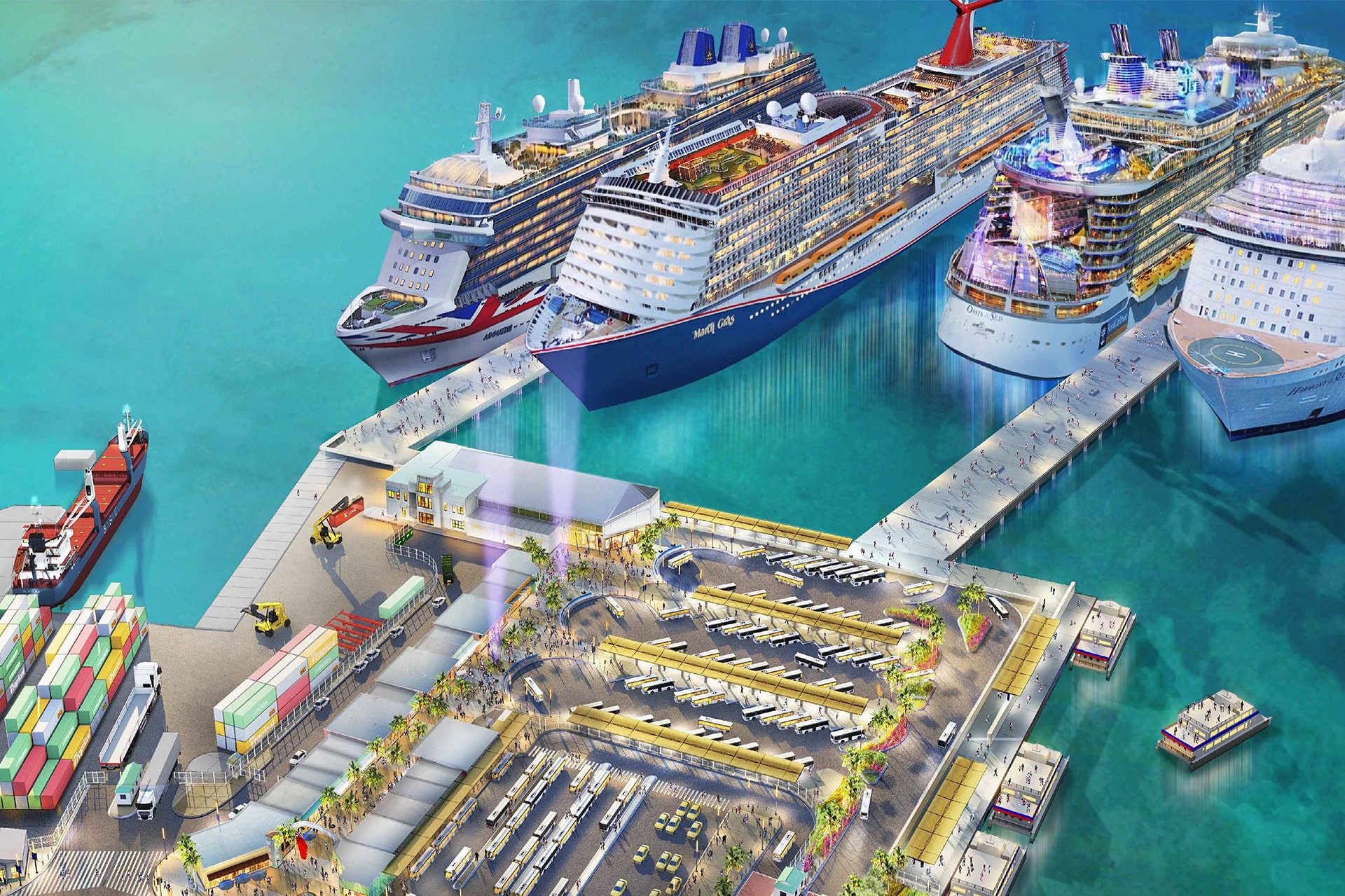Economic Concern

Source: Proposed cruise berthing facility and enhanced cargo port / Ministry of Tourism
We highlight some, but not all, of the numerous significant and unquantified risks where mitigation strategies could be (i) high cost (ii) unidentified (iii) based on unreliable data or (iv) subject to environmental uncertainty associated with this project.
Finance Model Transparency
What will Caymanians really pay for the project? Governments have a duty to deliver value-for-money projects with public finances.
Capital investment will be CI$196 million for Option 2 from the preferred bidder, Verdant Isle Consortium, funded by (1) 40% from its own capital (2) 60% through a bank loan. However, required feasibility studies and public infrastructure costs remain either unassessed or publicly undisclosed including: (1) Geotechnical study of George Town Harbour (2) George Town revitalisation (3) Road upgrades (4) Increased demand for island resources – waste management/water/electricity (5) Spotts Dock upgrades (6) Coral and shipwreck relocation.
What are the interest rates and payment terms to repay investors (1) Verdant Isle; and (2) on the Bank loan? Section 3.6 of the Outline Business Case (PWC report) indicates private cost of funds could be 10-15% per year, who will ultimately pay for this?

Government concessions
The USD$2.32 per head tax concession being given to the cruise lines, using 2018 numbers of 1.9 million passengers per year, is a direct loss to government revenue, i.e., Caymanians, of USD$4.4 million per year. Where is the value-for-money assessment?
Project management
Airport design flaws and overruns reported by the Auditor General have been significant, what will be done differently for this project?
Competitive disadvantage of cruise lines unable to berth
With berthing, cruise lines reported they would likely stop calling on Cayman if they were unable to berth (PWC report, pg.19). What will happen on days with more than four ships? Will other lines be willing to pay their competitors, Royal Caribbean and Carnival, to use the pier?
Cruise ship reputation and long-term outlook
Cruise tourism is vitally important to our islands and a positive cruiser experience is what we all want for Cayman. However, news and social media continue to highlight areas of concern over illegal activity, i.e., questionable practices by the industry such as fines and penalties for illegal activity, e.g., dumping of blackwater and garbage, as well as sanitation and safety issues.
Learning from other popular cruise destinations
Why aren’t we learning from jurisdictions reacting to over-tourism problems? Venice recently banned mega-ships, and Bruges, Dublin, Dubrovnik, Amsterdam and Santorini are introducing policies to limit or reduce cruise numbers. And cruise ships are crashing and damaging piers, e.g., Honduras, Puerto Rico, Buenos Aires, Bermuda.
Uncertainty
The valuation in the PwC Outline Business Case is subject to inherent limitations based on varying assumptions and unreliable/unavailable data which have significant implications for the results. These uncertainties are critical when considering whether this project will truly provide long-term benefits for Caymanians.
Final conclusion raises red flags
The PWC conclusion reads, “The impact of the CBF [cruise berthing facility] is still driven by the number of visitors to the Cayman Islands who participate in ‘diving’ [watersports activities] and their behaviour in response to any damage to the reefs in GTH [George Town Harbour]. “These questions are fundamental to the economic rationale of the CBF.”
Evidence directly from the international dive community demonstrates the extreme likelihood of undervaluation:
Ocean Futures Society President and Founder Jean-Michel Cousteau’s open letter to the Ministers of Tourism and Environment. (Cayman Compass, 4 Oct. 2018)
Mission Blue, founded by leading Oceanographer: Sylvia Earle, designated George Town Harbour as a ‘Hope Spot’. See here
- Ocean Futures Society President and Founder Jean-Michel Cousteau’s open letter to the Ministers of Tourism and Environment.
- Mission Blue, founded by leading Oceanographer: Sylvia Earle, designated GT Harbour as a “Hope Spot”.
- International petitions on the project shared by wide-reaching international organisations such as DEMA (Divers Equipment & Marketing Association) reaching over 30,000 signatures.
- Rainforest Rescue has launched an international petition: Don’t trash coral reefs for the cruise industry! Currently 172,000 signatures and aiming to attain 200,000.
International petitions on the project shared by wide-reaching international organisations such as DEMA (Divers Equipment and Marketing Association) reaching over 30,000 signatures.
Significantly, while approximately 80% of our annual tourism headcount comes from cruise and 20% from stayover, Caymanians benefit more from stayover guests whose dollar spending contributes approximately 80% of annual tourism revenue, the ‘80/20 rule’.
 Government should immediately release undisclosed information and set a referendum date which allows for completion of and public consultation on revised (1) Environmental Impact Assessment; and (2) Final Business Case reports to allow our citizens to make a fully informed evidence-based decision on this matter of national importance.
Government should immediately release undisclosed information and set a referendum date which allows for completion of and public consultation on revised (1) Environmental Impact Assessment; and (2) Final Business Case reports to allow our citizens to make a fully informed evidence-based decision on this matter of national importance.

Source: Cayman 2020 Town Hall Conference (Jan 2019)
Information has been obtained by CPR from publicly available reports found on the websites for the Department of Tourism www.supportourtourism.com and Department of Environment Www.doe.ky.
If you would like to receive more information, please contact us at: cprcayman@gmail.com.
Follow Us on Facebook: @cprcayman
